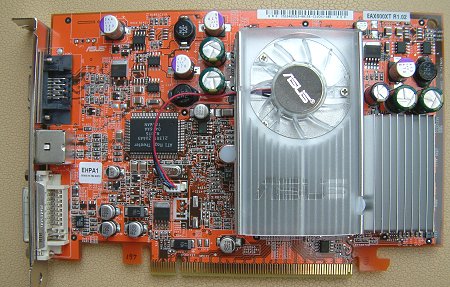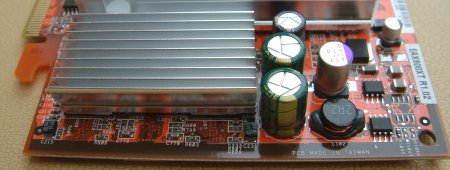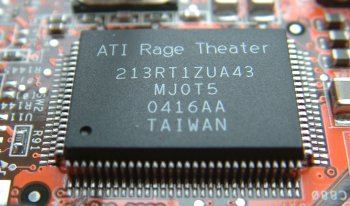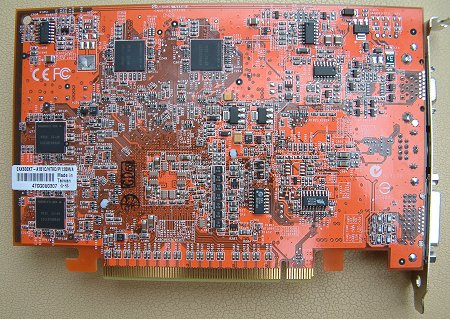AX600XT board examination

ASUS' ATI RADEON X600 XT-based card is an altogether different animal. The common trait between the two cards is the PCI-Express interface, but that's about it. It's a significantly smaller card that's far easier to install inside cramped cases. ATI's native PCIe X16 design takes away the need for a PCB-hogging bridge chip. ASUS chooses to go with another small-ish cooler design here, cut away in just the right places to allow for component placement.
A see-through plastic duct also forces air generated from the fan over the fins that sit just below. ASUS continues to add trendy a blue LED to good effect. My only concern, however, is with the expected high-pitched whine from the 40mm fan. SmartDoctor to the rescue, perhaps?. Expect to see these kind of cards in current midrange Dell PCs.

Midrange power is a good thing in many ways. GPUs should run fairly cool, cards are small, and there's no need for extra power. This PCIe version is clocks in with a core speed of 500MHz, equivalent to the AGP counterparts and 100MHz higher than the older 9600 Pro-based cards.

It's strange how companies often leave out VIVO on £400 graphics cards but absolutely insist on it with midrange and budget offerings. It's present on both midrange cards. ATI's basic Rage Theater ASIC may be getting on a bit in terms of launch date but it's still a worthwhile inclusion.

A look at the connections usually yields little to be excited about. A closer look on the left-hand side reveals that a regular HD15 VGA connector has been shunned and replaced by an HDTV connector (High-Definition Television). That's the first time I've personally seen it ship on a regular graphics card. Its usefulness in the U.K is pretty limited to a few displays right now, but HDTV-compatible LCD displays are now cropping up in increasing numbers.

Take a look at the very first picture and then translate the fan's position with the probable location of the X600 XT GPU. What you find is that the fan actually sits above the RAM modules and not the GPU (or VPU as ATI likes to call it). Core cooling is simply air vented down by the fan and on to the aluminium heatsink that's in direct contact. It seems as if ASUS was worried about the large deadspot arising from the fan sitting directly on top of the core.

ASUS has another pleasant surprise with its AX600XT/HTVD card. Going back to 9600 XT AGP cards for a moment, most are clocked in at 500MHz core and 600MHz memory. ASUS, though, has specified Hynix modules with a native 900MHz DDR rating. ASUS isn't quite as generous in its implementation. The AX600XT/HTVD's RAM modules run at 742MHz. There should be considerable scope for overclocking, though.









